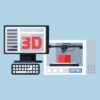3D Printers Market Summary:
The 3D printer market has witnessed significant growth in recent years, revolutionizing various industries and opening up new possibilities for innovation. These cutting-edge machines have the ability to create three-dimensional objects by layering materials such as plastic, metal, or even food, based on digital designs. With their increasing popularity, 3D printers are becoming more accessible and affordable, making them a valuable tool for businesses, hobbyists, and even educational institutions. One of the key drivers behind the growth of the 3D printer market is the versatility they offer. From manufacturing prototypes and customized products to creating intricate designs and architectural models, these printers have the potential to transform various industries. For example, in the healthcare sector, 3D printers are being used to create patient-specific implants and prosthetics, improving the quality of care and patient outcomes. Moreover, the adoption of 3D printers is also driven by the cost and time-saving benefits they provide. Traditional manufacturing methods can entail intricate tooling and protracted production cycles. In contrast, 3D printing allows for rapid prototyping and on-demand production, reducing both time and costs. This has made it easier for small businesses and startups to bring their ideas to life without the need for large-scale manufacturing facilities.
As the 3D printer market continues to evolve, advancements in technology are further enhancing their capabilities. From multi-material printing to the development of faster and more precise printers, manufacturers are constantly pushing the boundaries of what is possible. Additionally, the rise of open-source platforms and online communities has fostered collaboration and knowledge sharing, driving innovation and expanding the potential applications of 3D printing. The 3D printer market is experiencing rapid growth, driven by their versatility, cost-effectiveness, and technological advancements. As these machines become more accessible, we can expect to see further integration into various industries, unlocking new opportunities for creativity and efficiency. Whether it’s in healthcare, manufacturing, or even the arts, 3D printers are poised to revolutionize the way we create and produce objects in the future.
3D Printers Market Overview:
The 3D Printers Market overview provides a comprehensive understanding of the analyzed market. It includes an introduction to the market, its size, growth rate, and key trends. This aims to give clients a broad understanding of the market landscape. The market analysis of the 3D Printers Market delves deeper into the market dynamics, focusing on factors such as market drivers, challenges, and opportunities. It explores the macroeconomic and microeconomic factors affecting the market, industry regulations, and emerging market trends. The analysis provides valuable insights into the current and future market conditions.
The assessment of the 3D Printers Market is performed by taking various factors into consideration, like, for instance, the business expansion policies of key players, competitive analysis of the progress of new entrants and emerging players, and the revenue, financial, and opportunity analysis of market players. The also analyzed based on regional segmentation, type or technique, end-user spectrum, etc. This research implements the latest methodologies to help clients understand the overall market scenario and strategize accordingly. The 3D Printers Market report provides an overview of the different types of analysis conducted during the market research process, including but not limited to SWOT analysis, Porter's Five Forces analysis, PESTLE analysis, and market forecasting. These analyses provide a deeper understanding of the market dynamics and assist in making informed business decisions.
Major players included in the 3D Printers Market:
- Stratasys Ltd.
- EOS GmbH
- GE Additive
- HP Inc.
- 3D Systems Corporation
- DMG Mori Company Limited
- Renishaw Plc
- Formlabs Inc.
- Carbon Inc.
- Trumpf GmbH + Co. KG
- Markforged Inc.
- XYZPrinting Inc.
- The Exone Company
- Voxeljet AG
- Desktop Metal Inc.
3D Printers Market Segmentation:
By Type
- Industrial 3D Printer
- Desktop 3D Printer
By Technology
- Fused Deposition Modeling (FDM)
- Selective Laser Sintering (SLS)
- Stereolithography (SLA)
- Direct Metal Laser Sintering (DMLS)
- PolyJet
- MultiJet Fusion (MJF)
- Digital Light Processing (DLP)
- Binder Jetting
- Electron-Beam Melting (EBM)
- Directed Energy Deposition (DED)
- Laser Metal Fusion (LMF)
- Selective Absorption Fusion (SAF)
- LCD 3D Printing
By Material Usage
- Metal
- Polymer
- Ceramics
- Composites
- Resin
- Other Materials
By End-Use Application
- Industrial
- Aerospace & Defense
- Mounts & Fixtures
- Body & Spare Parts
- Weapon Printing
- Prototype and Test Unit
- Automotive
- Prototyping
- Custom & Spare Parts
- Mounts & Fixtures
- Consumer Products
- Electronic Products
- Jewelry & Luxury Goods
- Decorative Art
- Parts and Fixtures
- Semiconductors & Electronics
- IC & PCB
- Electronic Components
- Chemicals & Materials
- Medical
- Dental
- Instrument Printing
- Bioprinting Tissues and Organs
- Prototype and 3D Models
- Prosthetic Printing
- Energy
- Research & Development
- Oil & Gas
- Industrial Applications
- Machinery & Equipment Manufacturing
- Molds & Tools Printing
- Parts & Prototype Printing
- Aerospace & Defense
- 3D Printing Service Providers
Future Market Analytics Focus Points:
- SWOT Analysis
- Key Market Trends
- Key Data -Points Affecting Market Growth
- Revenue and Forecast Analysis
- Growth Opportunities For New Entrants and Emerging Players
- Key Player and Market Growth Matrix
3D Printers Market Competitive Analysis:
The competitive analysis of the 3D Printers Market assesses the competitive landscape of the market. It includes evaluating key players in the industry, their market share, business strategies, and competitive advantages. The competitive analysis also highlights the strengths and weaknesses of major competitors, allowing clients to understand the competitive positioning of companies operating in the market.
Objectives of the Study:
- To provide a comprehensive analysis on the 3D Printers Market by segmentation and by region
- To cater extensive insights on factors influencing the market growth (drivers, restraints, industry-specific restraints, business expansion opportunities)
- To anticipate and analyse the market size expansion in key regions- North America, Europe, Asia Pacific, Latin America and Middle East and Africa
- To record and evaluate competitive landscape mapping- strategic alliances and mergers, technological advancements and product launches, revenue and financial analysis of key market players
How our market research reports help clients:
Our market research reports provide valuable insights to clients in their decision-making process and support their growth and market capture efforts. They offer:
- Comprehensive understanding of market trends, dynamics, and growth potential.
- Identification of niche markets and emerging opportunities.
- Assessment of competitive landscape and strategic benchmarking.
- Insights into consumer preferences, buying behavior, and market demand.
- Risk assessment and mitigation strategies.
- Market forecasting and trend analysis for informed business planning.
- Understanding product development, pricing, and other strategies.
In case of any specific requirements or changes to the current table of content based on your scope, please contact us at: enquiry@futuremarketanalytics.com






















